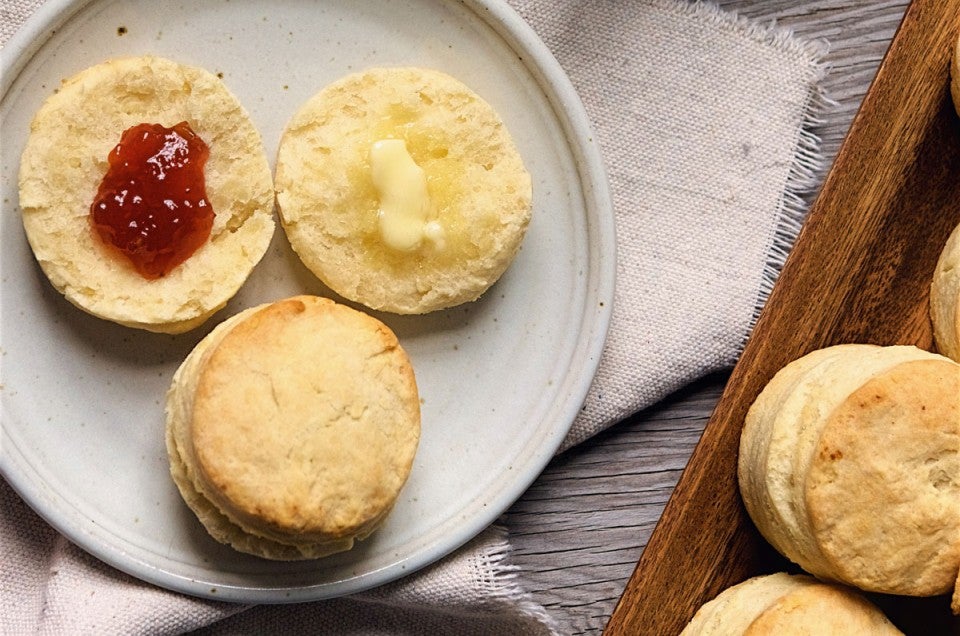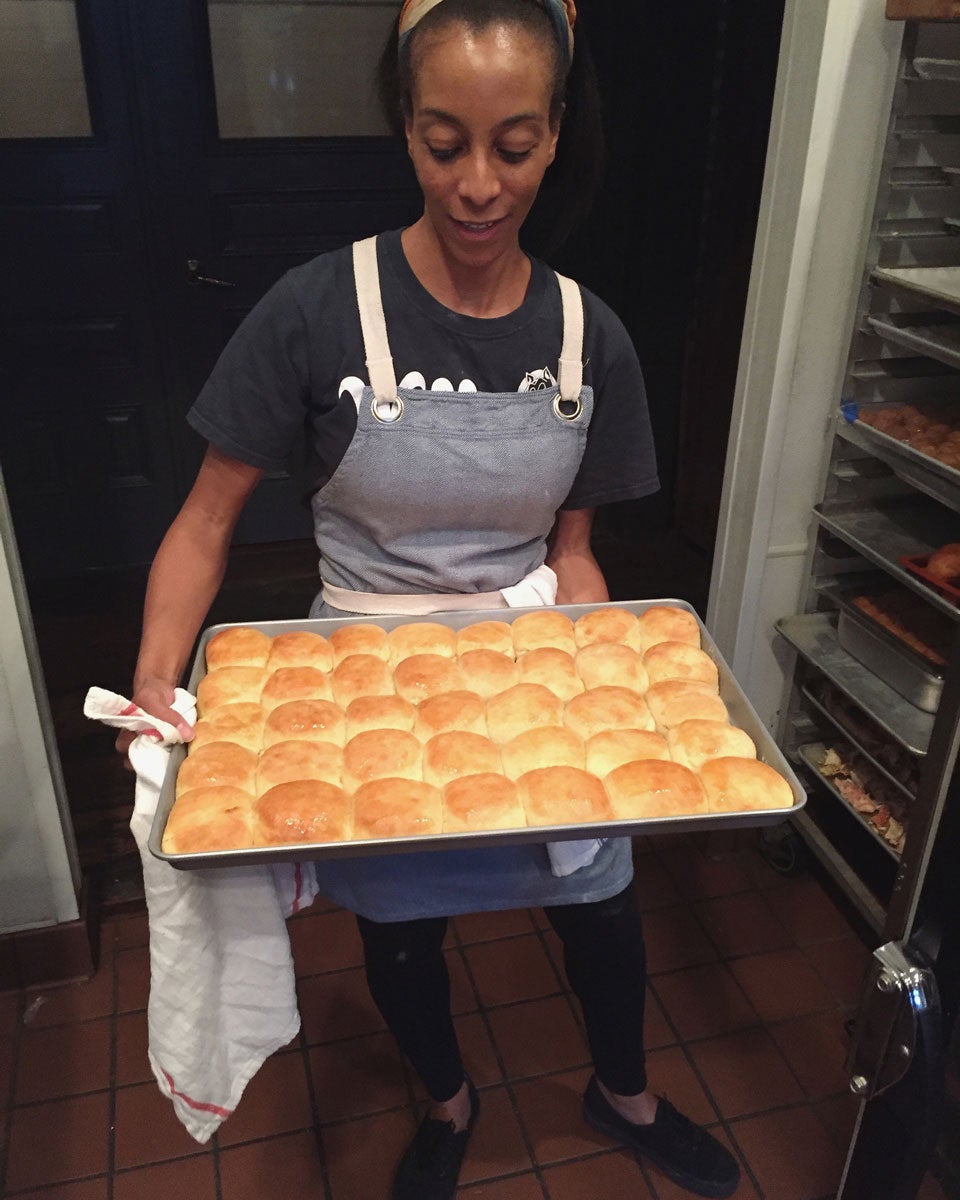Erika Council's tips for better biscuits
The award-winning baker continues her family’s legacy, one biscuit at a time.


Erika Council almost seemed destined to continue her family’s legacy in Southern cuisine. Her late paternal grandmother, Mildred Cotton Council, owned the legendary Mama Dip’s Kitchen in Chapel Hill, North Carolina. Council also has an award-winning blog, Southern Soufflé, and is the owner of Bomb Biscuit Co. in Atlanta, Georgia, where she creates flaky buttermilk biscuits that are achingly tender, yet hearty enough to cradle an ample smear of butter or jam — a combination of family recipes and her own updates over the years.
But for Council, the life she’s forged as a steward of her family’s traditions isn’t what she anticipated when she worked summers at Mama Dip’s Kitchen growing up. Council knew firsthand the work that went into running a successful restaurant and didn’t hold any romantic notions of being a restaurateur. “I worked in a restaurant for free, so I saw a different side of it very early on,” she says. “I just knew I wasn’t going to do this.” Council decided to take a different route, studying finance at North Carolina A&T University, followed by a career in finance and finance IT.

Council’s life took an unexpected turn when her maternal grandmother was diagnosed with Alzheimer's; she understood the urgency in recording her family history before it was too late. She started writing down her grandmother’s stories and created a blog to memorialize them, one that differed from other food blogs she read at the time. “Everything I read was very cookie-cutter,” Council remembers. “I started talking about my experiences with food that I wasn't reading. I was the only one writing about Black Lives Matter on a food blog … for me, there’s no separation.”
After moving from North Carolina to Atlanta, she launched Sunday Supper in 2014, an intimate dinner series held in her home. Her dinners were wildly successful, but there was one piece of feedback she received over and over again. “People would say, ‘Oh, these biscuits are good! Have you thought about selling your biscuits?’” Council says.
One of those guests was Bryan Furman of B's Cracklin' Barbecue, who was so impressed he asked her to run the breakfast program at his restaurant. Soon, her biscuits (which range from classic buttermilk to chocolate chip to bacon cheddar), breakfast sandwiches, and cinnamon rolls were gracing pop-ups throughout Atlanta; locals couldn’t satiate their appetite enough. It was the start of Bomb Biscuit Co. which now delivers those coveted biscuits nationwide.

Through Southern Soufflé, Bomb Biscuit Co., and more upcoming projects, Council’s work centers the soul and traditions of Southern cuisine — and keeps it aflame. It’s the food that nourished her all those summers ago, and she’s honored to preserve the culture. “I’m here because of African American foodways,” she says. “This has been my whole life.”
Based on her lifetime of baking, here are Council’s favorite tips for making better biscuits.

1) All-purpose flour is all good. “You don’t need flour from a fancy brand or self-rising flour to make biscuits,” Council says. She uses King Arthur all-purpose flour, which is 11.7% protein. (She rarely uses whole grain flours.) “You just need flour, your fat, and your liquid. Biscuits are the people’s food.”

2) Liquid measurements are a suggestion, not a rule. Council uses buttermilk for her biscuits and says the brand and quality of your buttermilk make a difference. Buttermilk from smaller purveyors is often thicker and creamier than commercial brands, Council explains, so the amount you need will depend on the brand. “Most people use commercial buttermilk that is just whole or 2% milk with additives to give it a sour taste, so it’s usually much thinner. When people make biscuits and it says 1 1/2 cups buttermilk, it might take less or more depending on what kind you use,” she says.
Since the viscosity of buttermilk can vary widely, it’s best to start off with slightly less than the recipe calls for, then adjust as needed. “My biggest tip is to start with the smaller amount. If a recipe calls for 1 cup of buttermilk, start with 3/4 cup before pouring all of it in there.” This goes for any liquid your recipe calls for.

3) Dough consistency is key. Working slowly and adding your liquid ingredients little by little is the key to getting a great biscuit dough that’s not too wet. “Your dough should look like a shaggy silly putty when you dump it out onto your work surface,” Council says. “You should be able to stick your finger in the dough without having it stick to your fingers.”
And if all else fails and your dough is a little too wet? Council says to roll out the dough, cut it into three sections, and stack them on top of each other. Once stacked, “Roll out the dough to how thick you want your biscuits to be, then cut it into circles. When it bakes, you’ll still have multiple layers,” which you’d otherwise lose with a wet dough.
4) Cut your butter with a mandolin. For the flakiest biscuits, Council uses a mandolin to cut frozen butter into sheets before mixing into the dough. “I can still see the sheets of butter when I’m making biscuit dough, kind of like pie crust,” she says. “It gives me more layers.”
5) Place your biscuits in the freezer before baking. Cold flour and butter are key to great biscuits, but not all is lost if you don’t have them on hand. “I always put my biscuits in the freezer after I've cut them out for about 30 minutes before I put them in the oven,” advises Council.

6) Cast iron creates a better crust. For biscuits that will be used for sandwiches, getting a sturdy bottom crust is key; for this, Council turns to her cast iron pan. “Put your cast iron on the stove and let it get hot before the biscuits go in the oven, and when you put your biscuits on there, the bottoms will bake up nice and crisp,” she says. “If you’re serving biscuits with gravy or a sandwich, it gives you that nice texture, and it doesn’t fall apart.”

7) For softer biscuits, don’t separate them before baking. For biscuits that are extra fluffy and soft around the edges, roll the dough and place it on a baking sheet, then cut the dough into circles — but leave the edges on. “It’s one of those things that has gone viral, but people have been leaving the edges on biscuits for a long time,” Council says. Plus, the leftover scraps make a delicious baker's treat.
Put Council's biscuit tips to use in one of King Arthur's many biscuit recipes, such as Buttermilk Biscuits, Buttery Sourdough Biscuits, and Gluten-Free Biscuits.
Photos courtesy of Erika Council, unless otherwise specified. Cover photo by Liz Neily.

